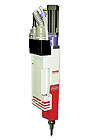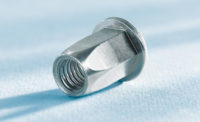
Dixon Automatic Tool Inc. (Rockford, IL) has introduced a machine that automatically feeds and installs threaded rivet nuts and studs.
Most fasteners that provide permanent load-bearing threads in thin materials require both sides of the workpiece to be accessible during installation and final assembly. When the workpiece can only be accessed from one side, threaded rivet nuts and studs provide a solution.
Threaded rivet nuts and studs are made from aluminum, brass, steel or stainless steel. Installed from the accessible side of the workpiece, rivet nuts and studs provide strong, permanent metal threads in metal or plastic sheets as thin as 0.02 inch. Rivet nuts and studs do not require additional hardware beyond a mating fastener.
In automobiles, rivet nuts and studs are used to attach mirrors, lights, luggage racks, radiators, spoilers and antilock braking modules. The fasteners are also used to attach trays to aircraft seats and handles and hinges to appliances. They are often installed in electronics cabinetry, as well as in roll forms, tubing, extrusions and other closed structures.
Dixon’s BMS electric rivet-setting machine can be mounted to a linear slide for use in conjunction with transfer lines or rotary indexing tables. It can also be mounted to a six-axis robot.
At the start of a cycle, a rivet nut or stud is delivered to the loading head via a vibratory feeder bowl and a flexible pneumatic tube. The riveting tool engages the fastener by spinning onto its threads. A torque sensor on the tool monitors the torque during this process. Any unexpected spike in torque could indicate a flaw in the fastener’s threads.
Once the fastener has been engaged, the loading head retracts and the tool inserts the fastener into a drilled or punched hole. When the tool is activated, the tip spins and retracts, bulging the unthreaded portion of the rivet shank against the reverse side of the sheet and locking the fastener permanently in place. The torque sensor ensures that the tool has installed the fastener with enough torque to adequately upset the rivet. Additional sensors on the tool monitor the force and displacement of the operation. Finally, the tip reverses direction so the tool can be removed.
The entire process, including feeding and quality checks, takes 6 to 7 seconds.
The BMS is available in two versions. Model 6200 installs rivet nuts in sizes M5 to M6. It applies a maximum torque of 15 newton-meters and a maximum riveting force of 7 kilonewtons. Model 6250 installs rivet nuts in sizes M6 to M8. It applies a maximum torque of 40 newton-meters and a maximum riveting force of 20 kilonewtons. The delivery stroke for both models is 100 millimeters. The riveting stroke is 15 millimeters.
For more information, call 815-226-3000 or visitwww.dixonautomatic.com/bms.
